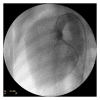Development of a closed chest model of chronic myocardial infarction in Swine: magnetic resonance imaging and pathological evaluation
- PMID: 24282645
- PMCID: PMC3825272
- DOI: 10.1155/2013/781762
Development of a closed chest model of chronic myocardial infarction in Swine: magnetic resonance imaging and pathological evaluation
Abstract
Our aim was to develop an easy-to-induce, reproducible, and low mortality clinically relevant closed-chest model of chronic myocardial infarction in swine using intracoronary ethanol and characterize its evolution using MRI and pathology. We injected 3-4 mL of 100% ethanol into the mid-LAD of anesthetized swine. Heart function and infarct size were assessed serially using MRI. Pigs were euthanized on days 7, 30, and 90 (n = 5 at each timepoint). Postoperative MRI revealed compromised contractility and decreased ejection fraction, from 53.8% ± 6.32% to 43.79% ± 7.72% (P = 0.001). These values remained lower than baseline thorough the followup (46.54% ± 11.12%, 44.48% ± 7.77%, and 40.48% ± 6.40%, resp., P < 0.05). Progressive remodeling was seen in all animals. Infarcted myocardium decreased on the first 30 days (from 18.09% ± 7.26% to 9.9% ± 5.68%) and then stabilized (10.2% ± 4.21%). Pathology revealed increasing collagen content and fibrous organization over time, with a rim of preserved endocardial cells. In conclusion, intracoronary ethanol administration in swine consistently results in infarction. The sustained compromise in heart function and myocardial thinning over time indicate that the model may be useful for the preclinical evaluation of and training in therapeutic approaches to heart failure.
Figures


Similar articles
-
AKT-modified autologous intracoronary mesenchymal stem cells prevent remodeling and repair in swine infarcted myocardium.Chin Med J (Engl). 2010 Jul;123(13):1702-8. Chin Med J (Engl). 2010. PMID: 20819633
-
A porcine model of ischemic heart failure produced by intracoronary injection of ethyl alcohol.Heart Vessels. 2011 May;26(3):342-8. doi: 10.1007/s00380-010-0022-3. Epub 2010 Oct 21. Heart Vessels. 2011. PMID: 20963597
-
Evolution of reperfusion post-infarction ventricular remodeling: new MRI insights.Int J Cardiol. 2013 Nov 20;169(5):354-8. doi: 10.1016/j.ijcard.2013.09.005. Epub 2013 Oct 6. Int J Cardiol. 2013. PMID: 24182681
-
[Magnetic resonance tomography imaging techniques for diagnosing myocardial vitality].Herz. 1994 Feb;19(1):51-64. Herz. 1994. PMID: 8150414 Review. German.
-
Clinical aspects of left ventricular diastolic function assessed by Doppler echocardiography following acute myocardial infarction.Dan Med Bull. 2001 Nov;48(4):199-210. Dan Med Bull. 2001. PMID: 11767125 Review.
Cited by
-
Cardiac MRI of differing ischemia and reperfusion times in a myocardial infarction pig model.Sci Rep. 2025 Jul 19;15(1):26270. doi: 10.1038/s41598-025-11390-3. Sci Rep. 2025. PMID: 40683945 Free PMC article.
-
Identification of very early inflammatory markers in a porcine myocardial infarction model.BMC Vet Res. 2019 Mar 12;15(1):91. doi: 10.1186/s12917-019-1837-5. BMC Vet Res. 2019. PMID: 30898123 Free PMC article.
-
Allogeneic cardiospheres delivered via percutaneous transendocardial injection increase viable myocardium, decrease scar size, and attenuate cardiac dilatation in porcine ischemic cardiomyopathy.PLoS One. 2014 Dec 2;9(12):e113805. doi: 10.1371/journal.pone.0113805. eCollection 2014. PLoS One. 2014. PMID: 25460005 Free PMC article.
-
ESC working group cellular biology of the heart: position paper: improving the preclinical assessment of novel cardioprotective therapies.Cardiovasc Res. 2014 Dec 1;104(3):399-411. doi: 10.1093/cvr/cvu225. Epub 2014 Oct 24. Cardiovasc Res. 2014. PMID: 25344369 Free PMC article. Review.
-
A total closed chest sheep model of cardiogenic shock by percutaneous intracoronary ethanol injection.Sci Rep. 2020 Jul 24;10(1):12417. doi: 10.1038/s41598-020-68571-5. Sci Rep. 2020. PMID: 32709984 Free PMC article.
References
-
- Monnet E, Chachques JC. Animal models of heart failure: what is new? Annals of Thoracic Surgery. 2005;79(4):1445–1453. - PubMed
-
- Sakaguchi G, Sakakibara Y, Tambara K, et al. A pig model of chronic heart failure by intracoronary embolization with gelatin sponge. Annals of Thoracic Surgery. 2003;75(6):1942–1947. - PubMed
LinkOut - more resources
Full Text Sources
Other Literature Sources

